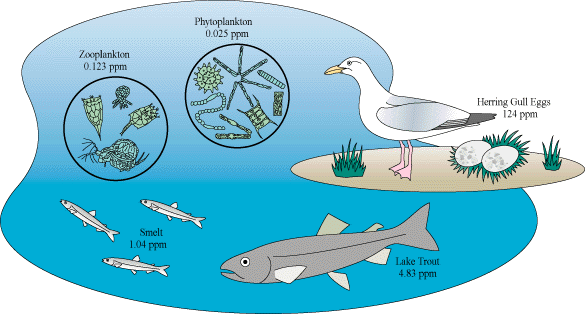SUMMARY
- All mercury compounds are are toxic and can be dangerous at very low levels in both aquatic and terrestrial ecosystems.
- Because mercury is a persistent substance, it can build up in living organisms, inflicting increasing levels of harm on higher order species such as predatory fish and fish eating birds and mammals through a process know as biomagnification.
- The most important pathway for mercury bioaccumulation is through the food chain.
- In the water, plants and small organisms like plankton take up mercury through passive surface absorption or through food intake.
- For autotrophic organisms (which do not eat other organisms), passive absorption is the only route of exposure.
- Heterotrophic organisms (animals which eat other life forms) may be exposed to dangerous concentrations through the food chain as predators eat other organisms and absorb the contaminants that their food sources contained.
- Over time, an individual who consumes plants or prey contaminated with methylmercury will acquire levels greater than in either its habitat or its food.
- As a result, top predators acquire greater body burdens of mercury than the fish they consume.
 |
| If the concentration of methylmercury in lake water is considered to have an absolute value of 1, then approximate bioaccumulation factors for microorganisms like phytoplankton are 105; for macroorganisms like zooplankton and planktivores are 106 ; and for piscivores like fish, birds and humans are 107 |
Almost all mercury compounds are toxic and can be dangerous at very low levels in both aquatic and terrestrial ecosystems. Because mercury is a persistent substance, it can build up, or bioaccumulate, in living organisms, inflicting increasing levels of harm on higher order species such as predatory fish and fish eating birds and mammals through a process know as "biomagnification". Although the long-term effects of mercury on whole ecosystems are unclear, the survival of some affected populations and overall biodiversity are at risk.
Methylmercury
Bioaccumulation

Methylmercury in Fish
Methylmercury is held tightly to fish protein when absorbed through the gills or when contaminated food sources are eaten. In some cases, methylmercury levels in carnivorous fish, such as freshwater bass, walleye and pike, and marine shark and swordfish, bioaccumulate up to a million times greater than in the surrounding water. Although fish appear to be tolerant to large body burdens of methylmercury, there have been human deaths in cases of severe poisoining. For example, in the 1950s, the Chisso Corporation in Minamata, Japan, released untreated effluent containing methyl mercury chloride into Minamata Bay. Once in the bay's sediments, the mercury was readily absorbed by marine species, contaminating the entire ecosystem. Fish consumed by local residents resulted in the deaths of more than 1000 individuals and severely impacted the developing fetuses of pregnant women.

Methylmercury in Wildlife
Piscivorous (fish eating) predators such as loons, merganser ducks, osprey, eagles, herons, and kingfishers, generally have very high concentrations of mercury. Mercury has been detected in Common Loons from Alaska to Atlantic Canada, and blood concentrations have been correlated with levels in prey fish species. High levels of mercury are suspected to impair the loon's reproductive success as well as cause growth related problems.These problems inevitably lead to an increased death rate and a decreased birth rate, resulting in a reduction in the abundance of natural populations.
[Taken from http://www.ec.gc.ca/mercure-mercury/default.asp?lang=en&n=d721ac1f-1 ]
Biomagnification

- Biomagnification is the buildup of substances (e.g. DDT, PCB) in the bodies of organisms at higher trophic levels of food webs.
- Organisms at lower trophic levels accumulate small amounts.
- Organisms at the next higher level eat many of these low level organisms and hence accumulate larger amount.
- At the highest trophic levels the increased concentrations in tissues may become toxic.
- When a higher level predator eats a lower level organism, it ingests the toxic substance (e.g. DDT, PCB) with its food.
- Even through the concentration of the toxic substance at lower trophic levels of the food chain may be in very low concentration, higher up the food chain the concentration is higher.
- DDT, PCB are organic pollutants which are not excreted nor decompose readily. They accumulate in adipose tissues.

QUIZ
Try this activity out to see if you really understand:http://oceanexplorer.noaa.gov/edu/learning/13_ocean_pollution/activities/biomagnification.html#activity





